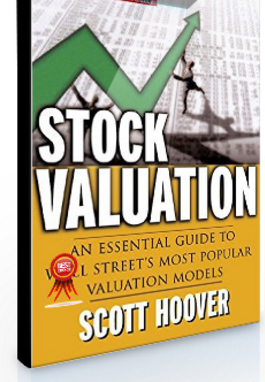
Scott Hoover – Stock Valuation
Price: $25
Please contact us: – Email: Tradersoffer@gmail -Skype: [email protected]
A practical look at the valuation models used by Wall Street
Veteran consultant and educator Scott Hoover analyzes the limitations and idiosyncrasies of major valuation models. He examines the time value of money, cash flow analysis, discount rates, and other tools, and describes how money managers and bankers apply them to valuation
Discover underpriced stocks before your competition does
Successful investing is about beating market benchmarks. To do this, you need to know how to identify, evaluate, and invest in mispriced stocks.
Stock Valuationprovides you with a hands-on examination of Wall Street’s most widely practiced valuation models, focusing on the theoretical underpinnings of those models and how they perform when applied to actual trades in the marketplace.
Accessible to sophisticated investors and indispensable for investment professionals,
Stock Valuation features:
- Step-by-step examination of the building blocks of accurate valuation, leading to the construction and implementation of a Discounted Cash Flow (DCF) model
- An instructive chapter-by-chapter valuation study of an actual company, providing examples of each concept applied in a real-life situation
- Strategies drawn from three investment professionals who have outperformed the markets over extended periods of time–Warren Buffett, Peter Lynch, and legendary mutual fund manager Bill Miller
Underpriced companies don’t generally announce their existence, but they do exist.
Stock Valuation describes the tools necessary to uncover and profit from underpriced stocks, before the rest of the market discovers them and closes the value gap.
Accurate stock valuation is a complex process, in which investors strive to eliminate variation and surprise while uncovering the signs that point to potentially valuable opportunities. And while professional investors know it is the numbers that truly tell the tale, they also know from experience that numbers derived on a spreadsheet often behave unpredictably when subjected to the give-and-take of the market.
Stock Valuation integrates the theoretical and the practical worlds into a single resource for the valuation of publicly traded companies. It carefully explains and provides in-depth details for each component of the valuation process. The book also shows you how to use this knowledge to arrive at accurate stock valuation in the real world, minimizing risk while substantially improving investment performance.
Stock Valuation features:
- A detailed look at of the investing community’s most popular valuation models–the Malkiel model, the DCF model, LBO analysis, trading comparables, and transaction comparables
- Examination of a company’s three main financial statements–the balance sheet, the income statement, and the statement of cash flows–and how to accurately interpret what each is saying
- “Time value of money” equations for assessing any stock or issue in virtually any investment situation
- Techniques for first measuring risk and converting that measure of risk into a corresponding required return
- Two approaches for forecasting future growth and free cash flows, one more comprehensive and the other more situation-specific
In
Stock Valuation, seasoned valuation practitioner and educator Scott Hoover has crafted a valuation guidebook that is both theoretically sound and consistent with how valuation is conducted by Wall Street professionals. Covering everything from price formation and present and future value of cash flows to discount rate calculation, analysis of key financial statements, capital structure and cost of capital, and more, it introduces the valuation techniques that investment professionals use, explains how and why they use each, and what investors can do to account for the possible biases, limitations, and idiosyncrasies they present.
About the Author
Scott Hoover is an award-winning assistant professor at Washington and Lee University An accomplished business valuation consultant, Hoover is a popular speaker for professional and academic conferences and has written articles for numerous business journals.
 Anthony Lee – The Ultimate AI Automation Bundle | Digital Download
1 × $89.00
Anthony Lee – The Ultimate AI Automation Bundle | Digital Download
1 × $89.00  Rob Lennon – Build Powerful GPTs | Digital Download
1 × $25.00
Rob Lennon – Build Powerful GPTs | Digital Download
1 × $25.00  Nathan Aston – Integromat Automation 2023 | Digital Download
1 × $55.00
Nathan Aston – Integromat Automation 2023 | Digital Download
1 × $55.00  Udemy – WordPress SEO – The Complete Yoast SEO Plugin Tutorial
1 × $15.00
Udemy – WordPress SEO – The Complete Yoast SEO Plugin Tutorial
1 × $15.00  Hidden Tempo – Comprehensive AI Training for Copywriters | Digital Download
1 × $45.00
Hidden Tempo – Comprehensive AI Training for Copywriters | Digital Download
1 × $45.00 

